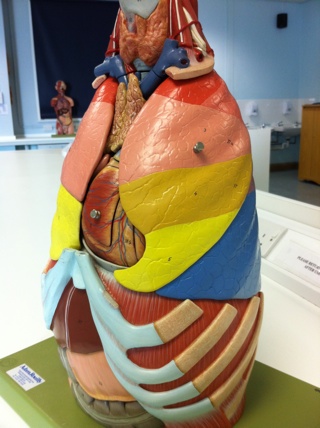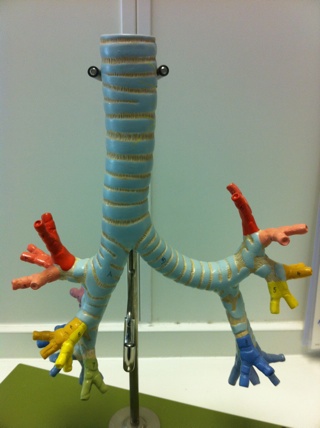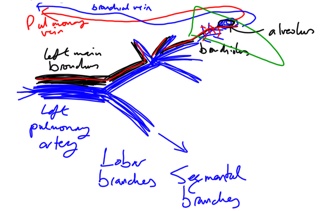
The Christmas holidays are over and we’re back to teaching (and learning). This week we went back to the lungs and added a little detail by looking at the pulmonary vessels in more detail, and adding the bronchial arteries and veins to this. As this is a teaching week about pulmonary embolism this anatomy should be very helpful.
We recapped how the pulmonary trunk comes out of the right ventricle of the heart, carrying deoxygenated blood towards the lungs. It splits into left and right pulmonary arteries, and each one passes into the hilum of a lung. These vessels are big. They’re carrying a lot of blood that will be ‘processed’ (for want of a better word), like we see in the liver and the kidneys. This isn’t blood that supplies the lung tissue as such, it is blood that needs some gases removed from it and other gases added to it.
The pulmonary arteries divide as soon as they enter the lung, and if you look at cadaveric lungs you may see this if they have been cut away from the body more deeply. A superior lobar branch passes to the upper lobe of the lung. In the left lung the other branch passes to the lower lobe as an inferior lobar branch. In the right lung a branch descends a little way and splits to give off lobar branches to the middle lobe and the lower lobe.
The lobar branches give off yet smaller branches, known as segmental branches. Branching continues until the pulmonary arteries (or arterioles when they become small) reach the alveoli and form capillary beds at the blood-air barrier, where gaseous exchange occurs.
The interesting thing here is that the branching pattern of the pulmonary arteries matches the branching pattern of the airways. I.e. the pulmonary arteries enter the hila of the lungs with the main bronchi, and the lobar branches pass with lobar bronchi, and segmental branches pass with segmental bronchi. Note that these branches of both structures may also be referred to as secondary (lobar) and tertiary (segmental) branches.
Remember that the bronchi continue as conducting bronchioles, then terminal bronchioles, and then respiratory bronchioles (and then alveoli).
From the capillary beds of the alveoli freshly oxygenated blood passes through small pulmonary venules, which drain into ever larger vessels, until they become the pulmonary veins and leave the lungs, returning this blood to the left side of the heart. Note that the tributaries (i.e. the branching pattern) of the pulmonary veins does not match the branching pattern of the airways. It looks very similar but it is located in a slightly different region.
The bronchi, pulmonary arteries and pulmonary veins are all great big tubes entering and leaving the lung at the hilum. There are some smaller vessels there too: the bronchial arteries and veins. The bronchial vessels help supply nutrients and oxygen to some parts of the lungs. The bronchial arteries also follow the airways, and can be found on the posterior surfaces of the bronchi and their branches. The two left bronchial arteries commonly come directly from the aorta, and the single right bronchial artery often comes from the (thirdish) posterior intercostal artery, but these origins are a little variable.
At the distal ends of these branches there are anastomoses between the bronchial arteries and the pulmonary arteries. In a younger, fitter adult these anastomoses may be helpful in minimising the ischaemic effects of a pulmonary embolus blocking a segmental pulmonary artery. Much of the blood that enters the lungs within the bronchial arteries leaves within the pulmonary veins. This mixing lowers the oxygen content of the blood within the pulmonary veins a little. Bronchial veins carry some blood away, and drain into the azygos vein (on the right) and the hemiazygos vein (on the left).
Consider the branching above. The smallest segment of a lung that is supplied by a segmental bronchus and a segmental branch of a pulmonary artery (and there will be a bronchial artery along side these two) is known as a bronchopulmonary segment.

This is handy to to be aware of. It would be possible to remove a single bronchopulmonary segment (say, because of a cancerous mass of cells) without affecting the function of any other bronchopulmonary segment. All the other parts of the lung would still have their own airway and blood supply. Also, if you know your bronchopulmonary segments and you know where a patient’s pulmonary embolus has lodged you can predict which parts of the lung are likely to be affected.
There are 10 bronchopulmonary segments in the right lung, and 8-10 bronchopulmonary segments in the left lung. Try to think of each segment as kind of pyramid shaped, with the base of the pyramid forming the outer surface of the lung and the pointy apex of the pyramid pointing towards the hilum (where the branches come from).
In between the bronchopulmonary segments are thin sheets of connective tissue. In these spaces between the segments the pulmonary veins are found, running towards the hila and out of the lungs.
Below is the diagram I sketched on the Smartboard during teaching. The black lines are the airways, the blue lines with them are the pulmonary arteries, the thin red line with them is the bronchial artery, and the other lines have labels. Amazing stuff. I hope it made sense at the time. Maybe I should draw this again slowly and it might become useful.
